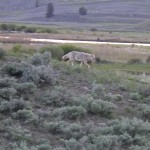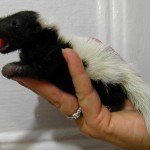 You know how Americans are appalled every time there’s a story out of China or Iraq about the government thugs primitively rounding up dogs and shooting them? Well, we do that, too. On purpose. Federal agents are out there killing dogs, more than one a day. They shot 157 dogs to death. And it’s not just in the yahoo states out west, either. (Although Texas and Arizona are the top states of dog-killing.) The USDA somehow insinuated itself into dog situations in 32 states. They went out and shot two dogs in Ohio and 30 in California. And it wasn’t because they feared they were rabid, either. They only tested 14 dogs for rabies.
Keep reading USDA Kills Another 4 million animals, including 477 dogs and 1,991 feral cats
 Ned–a female baby skunk–has a body like an over-inflated squirrel baby. She’s got a huge belly and feet that look like miniature grizzly bear paws.
Keep reading Meet Ned, Baby Skunk
 A room full of fawns
Today I got to visit a wildlife rehabiliator near Poughkeepsie who is far more experienced and patient than I am. Celie would need to be to handle the 98 animals in her care–including a pack of dogs, horses, chickens, birds and other permanent residents. But the reason my friend Vicki and I went to visit was that Celie got slammed by a big baby season.
Every May and June wildlife rehabilitators around the country get tons of calls from people who have found baby animals and birds. The usual correct response is to tell the person to put the animal back in exactly the spot where it was found because mom was just out getting food and she’s going to be pissed when she gets back. Wildlife rehabbers usually won’t take the animals unless they’re injured, orphaned or out on their own way too soon. But in many cases people know that the animals are orphaned because they find mom’s dead body nearby. In the case of many of the animals at Celie’s gorgeous farm, they were hit by cars.
possum family
For weeks straight she was getting many calls a day, all leading to more and more animals. She seemed to never say no. So Vicki and I headed up to help out. Really Vicki is used to mass animal raising, but I feel like I’m a farmhand just managing 8 or 9 squirrels. Basically I figured I could clean cages,
Keep reading Fawns Like to Nibble, Volunteer Visit to Wildlife Rehabber Shows

Big Run Wolf Ranch, Lockport, IL
Three species of wolves (British Columbian, Arctic and Grey Timber) interact intermingled in three different pens. Biology teacher Julie Basile and her husband John (who founded the ranch 18 years ago) track their interactions and move them to different groups when they see there’s trouble coming, either in the form of too rough dominance fights or mating season. Once secluded, the ranch is now crowded by houses and planned businesses. But the ranch is still growing. They visit schools or have nearby scouts and school groups come visit and learn about wolves. The wolves jump up and lick their caretakers.
In addition to the wolves, the Basiles have taken in other animals that need help and a place to live. Wildlife officials came to John in 2000 with a 20 pound black bear cub that someone had bought at a flea market for $200 and tried to raise in an apartment until neighbors thought better of the idea. They would have euthanized the bear, now known as Kuma, that day, but the ranch took the bear in and built a proper enclosure, pool, shower and hibernation hut. Kuma likes to show off to crowds and wrestles with John.The ranch also has several shy coyotes, wild cats, horses, dogs, peacocks and a rescued descented skunk. Kirby looks different than a wild skunk because he’s a domesticated variety and he smells different because he’s been descented. He’s friendly, cuddly and instintively holds
Keep reading Wolves and Bear Find Shelter with Chicagoland Biology Teacher
|
Subscribe SUBSCRIBE TO THE BLOG

|





Recent Comments